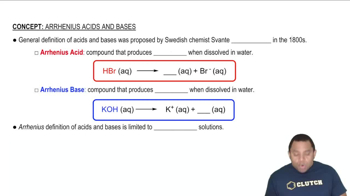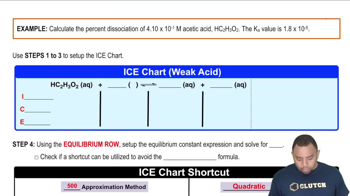We’ve said that alkali metal cations do not react appreciably with water to produce H3O+ ions, but in fact, all cations are acidic to some extent. The most acidic alkali metal cation is the smallest one, Li+, which has Ka = 2.5 * 10^-14 for the reaction: Li(H2O)4+ (aq) + H2O (l) ⇌ H3O+ (aq) + Li(H2O)3(OH) (aq). This reaction and the dissociation of water must be considered simultaneously in calculating the pH of Li+ solutions, which nevertheless have pH ≈ 7. Check this by calculating the pH of a 0.10 M LiCl solution.
 Verified step by step guidance
Verified step by step guidanceKey Concepts
Acid-Base Chemistry

Dissociation of Water

pH Calculation

During a certain time period, 4.0 million tons of SO2 were released into the atmosphere and subsequently oxidized to SO3. As explained in the Inquiry, the acid rain produced when the SO3 dissolves in water can damage marble statues: CaCO3(s) + H2SO4(aq) → CaSO4(aq) + CO2(g) + H2O(l) (a) How many 500 pound marble statues could be damaged by the acid rain? (Assume that the statues are pure CaCO3 and that a statue is damaged when 3.0% of its mass is dissolved.)
A 1.000 L sample of HF gas at 20.0 °C and 0.601 atm pressure was dissolved in enough water to make 50.0 mL of hydrofluoric acid. (a) What is the pH of the solution?
A 1.000 L sample of HF gas at 20.0 °C and 0.601 atm pressure was dissolved in enough water to make 50.0 mL of hydrofluoric acid. (b) To what volume must you dilute the solution to triple the percent dissociation?
